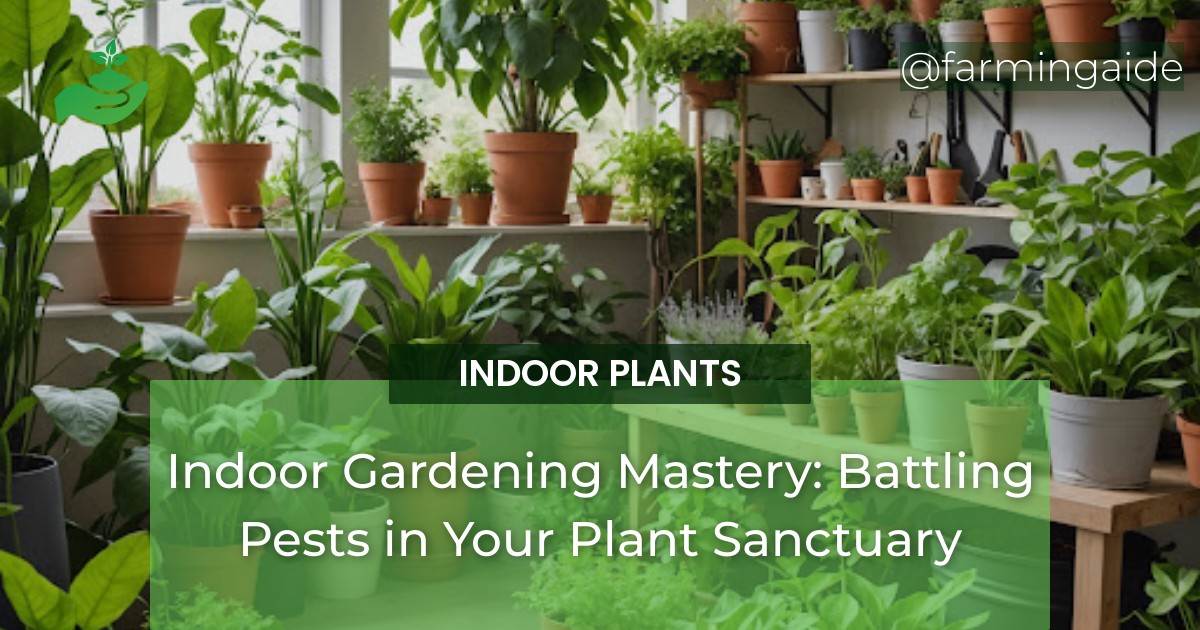As an indoor gardener, there’s nothing more disheartening than discovering that your prized plants have fallen prey to pests. These unwanted critters can quickly turn your lush oasis into a barren wasteland, leaving you feeling frustrated and helpless. But fear not, dear gardener! With the right knowledge and strategies, you can effectively battle pests in your indoor plant sanctuary and restore your plants to their former glory.
Key Takeaways
- Identifying common indoor plant pests and their impact on plant health
- Implementing preventive measures to deter pests from infesting your plants
- Using natural remedies and chemical treatments to eradicate pests
- Providing post-treatment care to restore plant health and prevent re-infestation
- Learning from experienced indoor gardeners and innovative pest control solutions
Understanding Common Indoor Plant Pests
Before we dive into the nitty-gritty of pest control, it’s essential to understand the common culprits that threaten our indoor gardens. Pests can be broadly categorized into three groups: insects, mites, and other invertebrates. Some of the most common indoor plant pests include spider mites, mealybugs, scale, whiteflies, and aphids.
These pests can cause significant damage to your plants, ranging from yellowing leaves and stunted growth to complete defoliation. Understanding the signs and symptoms of pest infestations is crucial to effective management and prevention.
Identifying Pest Infestations
Early detection is key to preventing pest infestations from spiraling out of control. Keep an eye out for the following signs:
- Unusual leaf drops or yellowing
- White, cottony patches or eggs on plant surfaces
- Tiny, moving dots on leaves or stems
- Holes or tears in leaves
- Sticky residue or honeydew droplets on leaves
Types of Pests and Their Impact
Here’s a brief rundown of some common indoor plant pests and their effects on plant health:
| Pest | Impact on Plant Health |
|---|---|
| Spider Mites | Causes yellowing leaves, stunted growth, and webbing on plants |
| Mealybugs | Feeds on plant sap, causing stunted growth and yellowing leaves |
| Scale | Drains plant sap, causing yellowing leaves, stunted growth, and reduced yields |
| Whiteflies | Transmits diseases, excretes honeydew, and causes yellowing leaves |
| Aphids | Feeds on plant sap, causing curled or distorted leaves and stunted growth |
Preventive Measures for Indoor Plant Pests
Prevention is always better than cure, and this adage holds true for indoor plant pests as well. By implementing the following preventive measures, you can significantly reduce the risk of pest infestations:
Optimal plant care is crucial in preventing pest infestations. Ensure your plants receive adequate light, water, and nutrients. Prune plants regularly to promote healthy growth and prevent overcrowding, which can attract pests.
ALSO READ
Optimal Plant Care to Deter Pests
A well-cared-for plant is less likely to attract pests. Here are some tips to keep your plants healthy and pest-free:
- Provide adequate light and temperature control
- Water plants properly, avoiding overwatering
- Fertilize plants regularly to promote healthy growth
- Prune plants regularly to prevent overcrowding
Environment Control for Pest Prevention
A clean and well-ventilated growing environment can go a long way in preventing pest infestations:
- Ventilate your growing space to prevent moisture buildup
- Regularly clean and disinfect surfaces and equipment
- Monitor temperature and humidity levels
- Use physical barriers to prevent pest migration
Effective Pest Control Techniques
When preventive measures fail, it’s essential to have a solid understanding of effective pest control techniques. Here are some natural and chemical treatment options to consider:
ALSO READ
Natural Remedies for Pest Eradication
Before reaching for chemical pesticides, consider these natural remedies:
- Neem oil: A natural insecticide that controls a wide range of pests
- Insecticidal soap: A mild pesticide that kills soft-bodied pests
- Horticultural oil: A refined mineral oil that controls pests and diseases
- Predatory insects: Encourage natural predators, like ladybugs and lacewings, to prey on pests
Chemical Treatments: When and How to Use Them
While chemical pesticides should be used sparingly, they can be effective in severe infestations:
- Systemic insecticides: Absorbed by plants to control pests internally
- Contact insecticides: Kill pests on contact, but may require repeated applications
- Read and follow label instructions carefully to avoid harming plants or the environment
Post-Treatment Care for Indoor Plants
After eradicating pests, it’s essential to provide post-treatment care to restore plant health:
Restoring Plant Health After Pest Control
Follow these tips to nurse your plants back to health:
- Prune damaged or infested areas to prevent re-infestation
- Provide optimal care, including adequate light, water, and nutrients
- Monitor plants closely for signs of re-infestation
Monitoring and Maintenance to Prevent Recurrence
To prevent re-infestation, maintain a clean and well-ventilated growing environment:
- Regularly inspect plants for signs of pests
- Clean and disinfect surfaces and equipment regularly
- Monitor temperature and humidity levels
Case Studies: Success Stories in Indoor Pest Management
Let’s take a look at some success stories in indoor pest management:
Lessons from Experienced Indoor Gardeners
We’ve gathered insights from experienced indoor gardeners who’ve successfully battled pests:
- Early detection is key to preventing infestations
- Preventive measures, like optimal plant care and environment control, are crucial
- Natural remedies and chemical treatments can be effective when used correctly
Innovative Pest Control Solutions
Here are some innovative pest control solutions to consider:
- Biological control agents, like beneficial nematodes, to target specific pests
- Traps and barriers to prevent pest migration
- Genetic breeding of pest-resistant plants
Conclusion and Future Strategies for Indoor Plant Health
In conclusion, battling pests in indoor gardening requires a multifaceted approach. By understanding common indoor plant pests, implementing preventive measures, and using effective pest control techniques, you can protect your plants from harm. Remember to provide post-treatment care, monitor plant health, and maintain a clean and well-ventilated growing environment to prevent re-infestation. Stay ahead of the game with innovative pest control solutions and share your success stories with the indoor gardening community.


